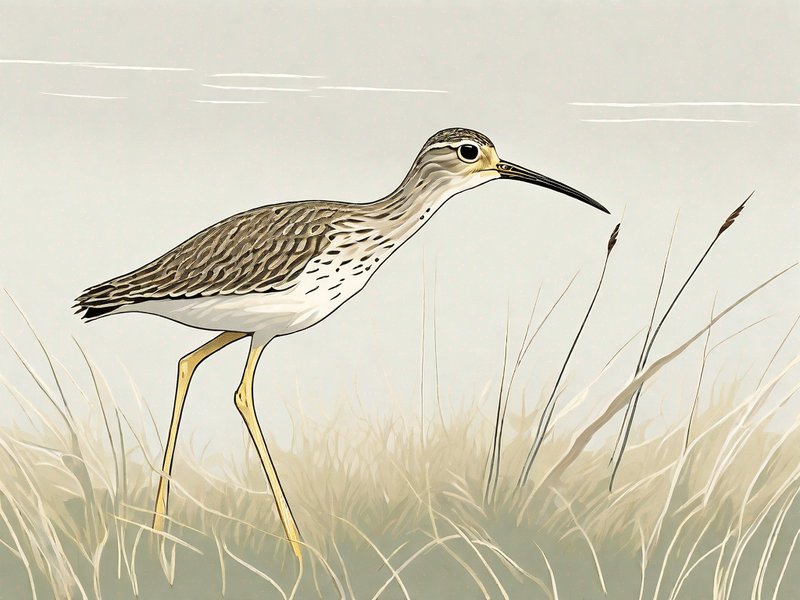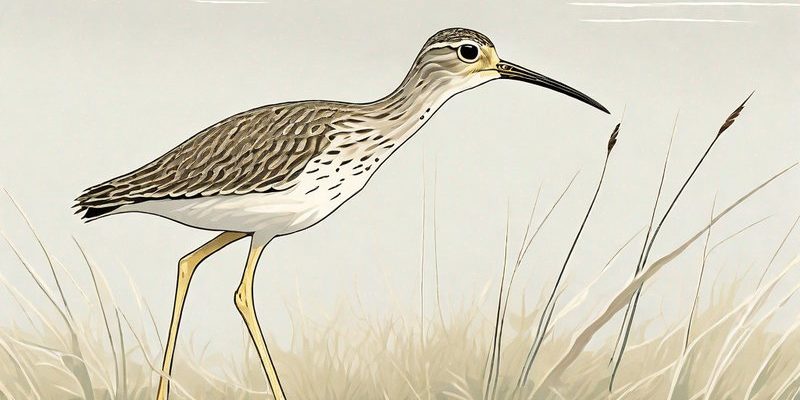
Have you ever heard of the Upland Sandpiper? This fascinating bird is often overlooked, but it plays a unique role in nature. As an insect-feeding bird, it has some incredible adaptations that help it thrive in various environments. You might picture a tiny creature flitting about, but the Upland Sandpiper is actually quite different—it’s more like a master of the open fields, expertly navigating its surroundings while hunting for tasty insects.
These birds have a special charm that makes them stand out among avian friends. With a long neck and slender body, the Upland Sandpiper is built for both elegance and efficiency. As they strut through fields and grasslands, they rely on their keen eyesight to spot insects in the grass, making them savvy hunters. Let’s dive deeper into what makes the Upland Sandpiper such an intriguing insect-feeding bird.
Physical Characteristics
The Upland Sandpiper is a bird that exudes grace. It has a long neck and slender body that can reach lengths of up to 12–14 inches. This size allows them to blend in with the tall grasses of their habitats, providing cover from potential predators. Their plumage is heavily patterned with shades of brown and buff, helping them camouflage in the soil and vegetation. This camouflage is essential for their survival, particularly during nesting season when they must protect their young from dangers.
One striking feature of the Upland Sandpiper is its long, slender legs. These legs allow them to travel quickly across open land, hunting for insects with agility. Their wingspan typically ranges from 26 to 28 inches, making them efficient flyers. When they take off, you can see the distinct white underside of their wings, a feature that sets them apart from other sandpipers. Their calls also contribute to their uniqueness; it’s a melodic, haunting sound that resonates through the fields, often signaling their presence long before you spot them.
Habitat and Range
You might wonder where you’d find the Upland Sandpiper. This bird typically resides in open grasslands, agricultural fields, and pastures. They prefer expansive areas where they can forage for insects and find places to nest. While they are adaptable, their primary preference leans toward landscapes that provide a mix of tall grass and open space. This combination gives them cover while allowing them to spot their food easily.
In terms of geographic range, the Upland Sandpiper is mostly found in North America. They breed in northern regions, especially in the northern United States and Canada, and during migration, they can be spotted in various locations across the continent. During the winter months, many migrate to warmer areas in Central and South America. This seasonal movement is critical for their survival, allowing them to seek out the best feeding opportunities.
Diet and Feeding Behavior
The Upland Sandpiper is known as an insect-feeding bird, and for good reason! Its diet primarily consists of insects, particularly grasshoppers, beetles, and crickets. These tasty morsels are not only nutritious but also plentiful in the environments where they thrive. The Upland Sandpiper’s long legs and sharp eyesight give it a significant advantage while hunting. They can spot movement in the grass, quickly pouncing on their prey with precision.
Feeding strategies of the Upland Sandpiper are fascinating. They often employ a method called “walking and scanning,” where they move slowly through their environment, pausing to observe and listen for any signs of insect activity. This careful approach allows them to take advantage of their natural surroundings. Occasionally, you may see them perform short bursts of flight—either to dislodge insects from the grass or to check for food from a higher vantage point.
| Attribute | Details |
|---|---|
| Size | 12–14 inches in length |
| Wingspan | 26–28 inches |
| Habitat | Open grasslands, agricultural fields, and pastures |
| Diet | Primarily insects such as grasshoppers, beetles, and crickets |
| Breeding Range | Northern United States and Canada |
| Migration | Wintering in Central and South America |
Breeding and Nesting
The breeding season for the Upland Sandpiper is a critical time filled with unique behaviors. Males are known for their elaborate displays to attract females. They perform impressive aerial displays, singing their sweet, melodious calls while soaring high above the ground. This not only showcases their fitness but also helps establish territory. During courtship, males may also engage in “ground display” behaviors, puffing out their chests and strutting around to capture the attention of potential mates.
Nesting usually occurs in tall grasses or fields, where the female will lay a clutch of 3 to 5 eggs, typically in a simple scrape in the ground. Once the eggs hatch, both parents are involved in caring for the young. The chicks are precocial, meaning they’re relatively mature and mobile shortly after hatching. They will follow their parents, learning to forage for food and hiding from predators among the tall grass.
Conservation Status
Like many bird species, the Upland Sandpiper faces challenges that threaten its populations. Habitat loss is one of the primary concerns. As agricultural expansion continues, much of their preferred grassland habitat disappears. Additionally, changes in land management practices can affect the food supply and nesting success of these birds. Fortunately, conservation efforts are underway to protect their habitats and ensure they continue to thrive in the wild.
Conservationists are working to create programs that promote sustainable agricultural practices that benefit both farmers and wildlife. For birdwatchers and nature enthusiasts, becoming involved in local conservation efforts or participating in citizen science projects can make a significant difference. By raising awareness and supporting habitat restoration initiatives, we can help protect the Upland Sandpiper and the delicate ecosystems they inhabit.
Interactions with Humans
Humans have a complex relationship with the Upland Sandpiper. For those involved in agriculture, these birds can be seen as both beneficial and a challenge. They help control insect populations that may harm crops, but they can also nest in areas where machinery operates. This duality requires careful management to ensure that farming activities do not disrupt their nesting.
Birdwatchers often seek out the Upland Sandpiper due to its unique characteristics and beautiful calls. This bird’s presence can indicate the health of grassland ecosystems, making it a valuable species for conservationists. Programs that promote eco-friendly practices can benefit both farmers and these charming birds, showing that with cooperation, we can coexist harmoniously.
FAQ
What is the range of the Upland Sandpiper?
The Upland Sandpiper primarily breeds in the northern regions of North America, particularly across the northern United States and Canada. During migration, these birds travel south to Central and South America, seeking warmer climates during the winter months. Their migratory patterns allow them to find optimal feeding and nesting areas throughout the year.
How do Upland Sandpipers find food?
Upland Sandpipers rely on their keen eyesight and quick reflexes to spot insects in the grass. They utilize a technique called “walking and scanning,” where they carefully move through their habitat, pausing regularly to observe their surroundings. This hunting technique allows them to efficiently locate and capture their prey, making them proficient insect feeders.
Are Upland Sandpipers social birds?
While Upland Sandpipers can be seen in pairs during the breeding season, they are generally considered solitary outside of this time. They prefer open spaces where they can stalk their prey without interference. However, you may find them in small groups during migration or in areas with abundant food resources, showing a bit more social behavior.
What is their song like?
The Upland Sandpiper has a distinctive and melodious song, often described as a series of flute-like whistles. This call plays a crucial role during courtship, helping males attract females and establish territory. If you’re in their habitat during the breeding season, listening for their calls can be a delightful experience.
How do Upland Sandpipers adapt to changing habitats?
Upland Sandpipers are surprisingly adaptable. While they prefer grasslands, they can often adjust to various agricultural fields as long as there’s enough cover and food available. Conservation efforts that focus on maintaining grassland habitats are vital for their survival, ensuring these birds have suitable places to thrive.
What do Upland Sandpipers do during the winter?
During the winter months, Upland Sandpipers migrate to warmer regions in Central and South America. They take advantage of the milder climates to find food and shelter until they return to their breeding grounds in North America. This seasonal migration is essential for their survival and allows them to avoid the harsher winter conditions.
How can people help protect Upland Sandpipers?
There are several ways individuals can contribute to the conservation of Upland Sandpipers. Supporting sustainable agricultural practices helps create a balance between farming and wildlife conservation. Additionally, getting involved in local conservation organizations or participating in habitat restoration projects can make a meaningful impact. Raising awareness about the Upland Sandpiper and its habitat needs can also encourage others to join in protecting this beautiful species.

